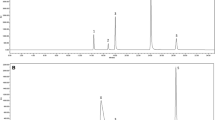Summary
The DMBA-TPA-mediated two-stage skin carcinogenesis experiment was modified in that pregnant mice were systemically treated once during pregnancy with the carcinogen. Intragastric application times were fetal days 6, 8, and 10–20. A control group of pregnant mice received repeated doses (from days 8–20) of sesame oil, which was used as a solvent for DMBA.
At the age of 12 weeks, the offspring of the control group were divided into two groups, one of which was left completely untreated, the other received TPA applications over 26 weeks.
The 12-week old F 1-progeny of each transplacentally initiated group was also divided into subgroups, which either received no further treatment (subgroups A) or were promoted with TPA (subgroups B). Neither the F 1-animals of the two control groups nor that of the transplacentally initiated but postnatally not promoted subgroups 6A–20A developed skin tumors. The same holds true for the TPA-promoted offsprings of mother animals which had received DMBA at days 6 and 8 of gestation.
Skin tumor development after TPA promotion was first observed in animals of subgroup 10B. Thereafter, tumor rates and tumor yields increased and latency periods decreased progressively in the B-subgroups with the postponenment of initiation to later fetal periods. Day 19 of prenatal development proved to be the most sensitive period to transplacental initiation, whereas initiation at day 20 led to a significant decrease in tumor rate and yield.
The capability to initiate skin tumors and the extent of initiation can be correlated to both the organogenesis of the epidermis and its proliferative rate in utero.
Similar content being viewed by others
Abbreviations
- DMBA:
-
7,12-dimethylbenz(a)anthracene
- TPA:
-
12-tetradecanoylphorbol-13-acetate
- AHM/EH:
-
arythydrocarbon-monooxygenase/epoxide hydra(ta)se
References
Balmain A, Loehren D, Fischer J, Alonso A (1977) Protein synthesis during fetal development of mouse epidermis. I. The appearance of histidine-rich protein. Dev Biol 60:442–452
Du Brul EF (1972) Fine structure of epidermal differentiation in the mouse. J Exp Zool 181:145–158
Dunn OJ (1964) Multiple comparisons using rank sums. Technometrics 6:241–252
Gabriel KR (1966) Simultaneous test procedures for multiple comparisons on categorical datas. J Am Stat Assoc 61:1081–1096
Goerttler K, Loehrke H (1976) Diaplacental carcinogenesis: initiation with the carcinogens DMBA and urethane and postnatal promotion with the phorbol ester TPA in a modified Berenblum-Mottram experiment. Virchows Arch [Pathol Anat] 372:29–38
Goerttler K, Loehrke H (1977) Diaplacental carcinogenesis: tumor localization and tumor incidence in NMRI-mice after diaplacental initiation with DMBA and urethane and postnatal promotion with the phorbol ester TPA in a modified 2-stage Berenblum-Mottram experiment. Virchows Arch [Pathol Anat] 376:117–122
Hanson J (1947) The histogenesis of the epidermis in the rat and mouse. J Anat 81:174–197
Kruskal WH, Wallis WA (1952) Use of ranks in one-criterion variance analysis. J Am Stat Assoc 47:583–621
Nakamura H, Yasuda M (1979) An electron-microscopic study of periderm cell development in mouse limb buds. Anat Embryol 157:121–132
Nebert DW, Gelboin HV (1969) The in vivo and in vitro induction of arylhydrocarbon hydroxylase in mammalian cells of different species, tissues, strains, and developmental and hormonal states. Arch Biochem Biophys 134:76–89
Nebert DW, Gielen JE (1972) Genetic regulation of arylhydrocarbon hydroxylase induction in the mouse. Fed Proc 31:1315–1325
Oesch F (1976) Differential control of rat microsomal arylhydrocarbon monooxygenase and epoxide hydratase. J Biol Chem 251:79–87
Pyerin WG, Hecker E (1979) On the biochemical mechanism of tumor genesis in mouse skin. IX. Interrelation between tumor initiation by DMBA and the activities of epidermal arylhydrocarbon monooxygenase and epoxide Hydratase. J Cancer Res Clin Oncol 93:7–30
Pyerin WG, Hecker E (1980) Tumor initiation in mouse skin by DMBA: Irrelevance of systemic activation. Cancer Lett 8:317–321
Schweizer J, Marks F (1977) A development study of the distribution and frequency of Langerhans' cells in relation to formation of patterning in mouse tail epidermis. J Invest Dermatol 69:198–204
Steiner K, Hitchmann O (1927) Über die Entstehung der Basalmembran des Hautepithels. I. Die Entwicklung der Basalmembran bei Mus decumanus albus. Z Zellforsch 5:150–173
Stern IB, Dayton L, Duecy J (1971) The uptake of tritiated thymidine by the dorsal epidermis of the fetal and newborn rat. Anat Rec 170:225–234
Suntzeff V, Carruthers C, Cowdry EV (1947) The role of sebaceous glands and hair follicles in epidermal carcinogenesis. Cancer Res 7:439–443
Weiss LW, Zelickson AS (1975) Embryology of the epidermis: ultrastructural aspects. I. Formation and early development of the mouse with mammalian comparisons. Acta Dermatovenerol 55:161–168
Weiss LW, Zelickson AS (1975) Embryology of the epidermis: ultrastructural aspects. II. Period of differentiation in the mouse with mammalian comparisons. Acta Dermatovenerol 55:321–329
Weiss LW, Zelickson AS (1975) Embryology of the epidermis: ultrastructural aspects. III. Maturation and primary appearance of dendritic cells in the mouse with mammalian comparisons. Acta Dermatovenerol 55:431–442
Zeller WJ (1974) Probleme der diaplacentaren Carcinogenese. Geburtsh Frauenheilk 34:1001–1006
Author information
Authors and Affiliations
Additional information
Dedicated to Professor Dr. Gottfried Hebold on the occasion of his 60th birthday
Rights and permissions
About this article
Cite this article
Goerttler, K., Loehrke, H., Schweizer, J. et al. Two-stage skin carcinogenesis by systemic initiation of pregnant mice with 7,12-dimethylbenz(a)anthracene during gestation days 6–20 and postnatal promotion of the F1-generation with the phorbol ester 12-tetradecanoylphorbol-13-acetate. J Cancer Res Clin Oncol 98, 267–275 (1980). https://doi.org/10.1007/BF00410789
Received:
Accepted:
Issue Date:
DOI: https://doi.org/10.1007/BF00410789




